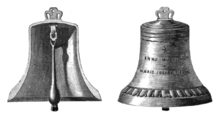Big Ben
Big Ben is the nickname for the Great Bell of the striking clock at the north end of the Palace of Westminster in London[1] and is usually extended to refer to both the clock and the clock tower.[2][3] The official name of the tower in which Big Ben is located was originally the Clock Tower; it was renamed Elizabeth Tower in 2012 to mark the Diamond Jubilee of Elizabeth II, Queen of the United Kingdom.
| Elizabeth Tower | |
|---|---|
 | |
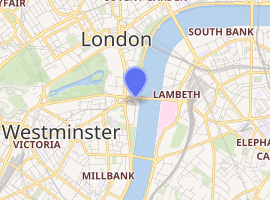
| |
| Alternative names | Big Ben |
| General information | |
| Type | Clock tower |
| Architectural style | Gothic Revival |
| Location | Westminster, London, England |
| Coordinates | 51.5007°N 0.1245°W |
| Completed | 31 May 1859 |
| Height | 96 metres (315 ft) |
| Technical details | |
| Floor count | 11 |
| Design and construction | |
| Architect | Augustus Pugin |
The tower was designed by Augustus Pugin in a neo-Gothic style. When completed in 1859, its clock was the largest and most accurate four-faced striking and chiming clock in the world.[4] The tower stands 315 feet (96 m) tall, and the climb from ground level to the belfry is 334 steps. Its base is square, measuring 39 feet (12 m) on each side. Dials of the clock are 23 feet (7.0 m) in diameter. On 31 May 2009, celebrations were held to mark the tower's 150th anniversary.[5]
Big Ben is the largest of the tower's five bells and weighs 13.5 long tons (13.7 tonnes; 15.1 short tons).[1] It was the largest bell in the United Kingdom for 23 years. The origin of the bell's nickname is open to question; it may be named after Sir Benjamin Hall, who oversaw its installation, or heavyweight boxing champion Benjamin Caunt. Four quarter bells chime at 15, 30 and 45 minutes past the hour and just before Big Ben tolls on the hour. The clock uses its original Victorian mechanism, but an electric motor can be used as a backup.
The tower is a British cultural icon recognised all over the world. It is one of the most prominent symbols of the United Kingdom and parliamentary democracy,[6] and it is often used in the establishing shot of films set in London.[7] The clock tower has been part of a Grade I listed building since 1970 and a UNESCO World Heritage Site since 1987.
On 21 August 2017, a four-year schedule of renovation works began on the tower, which are to include the addition of a lift. There are also plans to re-glaze and repaint the clock dials. With a few exceptions, such as New Year's Eve and Remembrance Sunday, the bells are to be silent until the work is completed in 2021.
Tower
Origin
Elizabeth Tower, previously called the Clock Tower but more popularly known as Big Ben,[3][5] was raised as a part of Charles Barry's design for a new palace, after the old Palace of Westminster was largely destroyed by fire on the night of 16 October 1834.[8][9] The new parliament was built in a neo-gothic style. Although Barry was the chief architect of the palace, he turned to Augustus Pugin for the design of the clock tower, which resembles earlier Pugin designs, including one for Scarisbrick Hall in Lancashire. The design for the tower was Pugin's last design before his final descent into madness and death, and Pugin himself wrote, at the time of Barry's last visit to him to collect the drawings: "I never worked so hard in my life for Mr Barry for tomorrow I render all the designs for finishing his bell tower & it is beautiful."[10]
Design
The tower is designed in Pugin's celebrated Gothic Revival style, and is 315 feet (96.0 m) high.[11] The bottom 200 feet (61.0 m) of the tower's structure consists of brickwork with sand-coloured Anston limestone cladding. The remainder of the tower's height is a framed spire of cast iron. The tower is founded on a 50 feet (15.2 m) square raft, made of 10 feet (3.0 m) thick concrete, at a depth of 13 feet (4.0 m) below ground level. The four clock dials are 180 feet (54.9 m) above ground. The interior volume of the tower is 164,200 cubic feet (4,650 cubic metres).
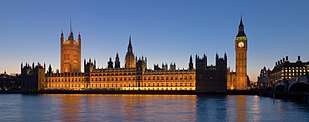
Despite being one of the world's most famous tourist attractions, the interior of the tower is not open to overseas visitors, though United Kingdom residents were able to arrange tours (well in advance) through their Member of Parliament before the current repair works.[12] However, the tower currently has no lift, though one is being installed, so those escorted had to climb the 334 limestone stairs to the top.[11]
Due to changes in ground conditions since construction, the tower leans slightly to the north-west, by roughly 230 millimetres (9.1 in) over 55 m height, giving an inclination of approximately 1⁄240. This includes a planned maximum of 22 mm increased tilt due to tunnelling for the Jubilee line extension.[13] It leans by about 500 millimetres (20 in) at the finial. Experts believe the tower's lean will not be a problem for another 4,000 to 10,000 years.[14] Due to thermal effects it oscillates annually by a few millimetres east and west.
Name
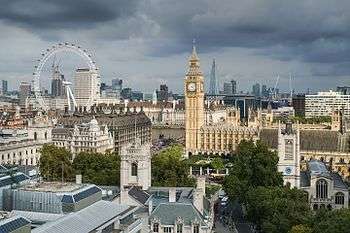
Journalists during Queen Victoria's reign called it St Stephen's Tower. As MPs originally sat at St Stephen's Hall, these journalists referred to anything related to the House of Commons as news from "St. Stephens" (the Palace of Westminster contains a feature called St Stephen's Tower, a smaller tower over the public entrance).[8] The usage persists in Welsh, where the Westminster district, and Parliament by extension, is known as San Steffan.
On 2 June 2012, The Daily Telegraph reported that 331 Members of Parliament, including senior members of all three main parties, supported a proposal to change the name from Clock Tower to Elizabeth Tower in tribute to Queen Elizabeth II in her diamond jubilee year. This was thought to be appropriate because the large west tower now known as Victoria Tower was renamed in tribute to Queen Victoria on her diamond jubilee.[15] On 26 June 2012, the House of Commons confirmed that the name change could go ahead.[16] The Prime Minister, David Cameron, announced the change of name on 12 September 2012 at the start of Prime Minister's Questions.[17] The change was marked by a naming ceremony in which the Speaker of the House of Commons, John Bercow, unveiled a name plaque attached to the tower on the adjoining Speaker's Green.[18]
Clock
Dials

The clock and dials were designed by Augustus Pugin. Each clock dial is set in an iron frame 23 feet (7.0 m) in diameter that supports 324 pieces of opal glass, rather like a stained-glass window. Some of the glass pieces may be removed for inspection of the hands. The surrounds of the dials are gilded. At the base of each clock dial, in gilt letters, is the Latin inscription:
DOMINE SALVAM FAC REGINAM NOSTRAM VICTORIAM PRIMAM
which means O Lord, keep safe our Queen Victoria the First.
Unlike many other Roman numeral clock dials, which show the '4' position as IIII, the Great Clock faces depict '4' as IV.
Movement

The clock's movement is famous for its reliability. The designers were the lawyer and amateur horologist Edmund Beckett Denison, and George Airy, the Astronomer Royal. Construction was entrusted to clockmaker Edward John Dent; after his death in 1853 his stepson Frederick Dent completed the work, in 1854.[19] As the tower was not complete until 1859, Denison had time to experiment: instead of using the deadbeat escapement and remontoire as originally designed, Denison invented the double three-legged gravity escapement. This escapement provides the best separation between pendulum and clock mechanism. The pendulum is installed within an enclosed windproof box beneath the clockroom. It is 13 feet (4.0 m) long, weighs 660 pounds (300 kg), suspended on a strip of spring steel 1⁄64 inch (0.40 mm) in thickness, and beats every two seconds. The clockwork mechanism in a room below weighs five tons.
On top of the pendulum is a small stack of old penny coins; these are to adjust the time of the clock. Adding a coin has the effect of minutely lifting the position of the pendulum's centre of mass, reducing the effective length of the pendulum rod and hence increasing the rate at which the pendulum swings. Adding or removing a penny will change the clock's speed by 0.4 seconds per day.[20] The clock is hand wound (taking about 1.5 hours)[21] three times a week.[22]
On 10 May 1941, a German bombing raid damaged two of the clock's dials and sections of the tower's stepped roof and destroyed the House of Commons chamber. Architect Sir Giles Gilbert Scott designed a new five-floor block. Two floors are occupied by the current chamber, which was used for the first time on 26 October 1950. The clock ran accurately and chimed throughout the Blitz.[23]
Breakdowns and other incidents
19th century
Before 1878: The clock stopped for the first time in its history, "through a heavy fall of snow" on the hands of a clock face.[24][25]
21 August 1877-January 1878: The clock was stopped for three weeks to allow the tower and mechanism to be cleaned and repaired. The old escape wheel was replaced.[24]
February 1900: The heavy build-up of snow on a clock face impeded the progress of the hour hand, causing the clock to stop for about eight hours.[26]
20th century
1916: For two years during World War I, the bells were silenced and the clock faces were not illuminated at night to avoid guiding attacking German Zeppelins.[11]
29 December 1927: Snow build-up on a clock face stopped the clock.[27]
Winter 1928: Heavy snow stopped the clock for several hours.[26]
2 April 1934: The clock stopped from 7:16 a.m. to 1:15 pm, when it was repaired.[28]
23 September 1936: A painter painting the inside of the clock room placed a ladder against a shaft driving the hands, stopping the clock from 8:47 to 10 am.[26]
1 September 1939: Although the bells continued to ring, the clock faces were not illuminated at night throughout World War II to avoid guiding bomber pilots during the Blitz.[11]
10 May 1941: A German bombing raid damaged two of the clock's dials.
3–4 June 1941: The clock stopped from 10:13 p.m. until 10:13 the following morning, after a workman repairing air-raid damage to the clock face left a hammer too close to the mechanism.[29][26]
25–26 January 1945: Extremely cold temperatures froze the rubber bushings on the quarter-bell hammers, preventing the chimes sounding from 9 p.m. on the 25th to 9 p.m. the following evening; the BBC broadcast the pips in the interval.[26]
28 January 1947: The rubber bushings on the quarter bell hammers again froze before the clock sounded midnight, muting the chimes, though the problem was resolved by the morning.[26]
12 August 1949: The clock slowed by four and a half minutes after a flock of starlings perched on the minute hand.[30][26]
13 January 1955: The clock stopped at 3:24 a.m. due to drifts of snow forming on the north and east dials. Small electric heaters were placed just inside these two dials which faced the full fury of the winter's blast, and this measure has helped to reduce instances of freezing in recent years.[26]
18 July 1955: The rope operating the striking hammer broke, silencing the clock from 10 a.m. to 5 pm.[26]
New Year's Eve 1962: The clock slowed due to heavy snow and ice on the hands, causing the pendulum to detach from the clockwork, as it is designed to do in such circumstances, to avoid serious damage elsewhere in the mechanism – the pendulum continuing to swing freely. Thus, it chimed-in the 1963 new year nine minutes late.[31]
30 January 1965: The bells were silenced during the funeral of statesman and former prime minister Winston Churchill.[32]
9 January 1968: Snow buildup on the clock faces blocked the hands from moving, stopping the clock from 6:28 to 10:10 am.[26]
5 August 1976: First and only major breakdown. The air brake speed regulator of the chiming mechanism broke from torsional fatigue after more than 100 years of use, causing the fully wound 4-ton weight to spin the winding drum out of the movement, causing much damage. The Great Clock was shut down for a total of 26 days over nine months – it was reactivated on 9 May 1977. This was the longest break in operation since its construction. During this time BBC Radio 4 broadcast the pips instead.[33] Although there were minor stoppages from 1977 to 2002, when maintenance of the clock was carried out by the old firm of clockmakers Thwaites & Reed, these were often repaired within the permitted two-hour downtime and not recorded as stoppages. Before 1970, maintenance was carried out by the original firm of Dents; since 2002, by parliamentary staff.
March 1986 and January 1987: The problem of the rubber bushings on the quarter bell chimes freezing recurred, muffling the chimes.[26]
30 April 1997: The clock stopped 24 hours before the general election, and stopped again three weeks later.[34]
21st century

27 May 2005: The clock stopped at 10:07 pm, possibly because of hot weather; temperatures in London had reached an unseasonable 31.8 °C (90 °F). It resumed, but stopped again at 10:20 pm, and remained still for about 90 minutes before resuming.[34]
29 October 2005: The mechanism was stopped for about 33 hours to allow maintenance work on the clock and its chimes. It was the lengthiest maintenance shutdown in 22 years.[35]
7:00 a.m. 5 June 2006: The clock tower's "Quarter Bells" were taken out of commission for four weeks[36] as a bearing holding one of the quarter bells was worn and needed to be removed for repairs. During this period, BBC Radio 4 broadcast recordings of British bird song followed by the pips in place of the usual chimes.[37]
11 August 2007: Start of 6-week stoppage for maintenance. Bearings in the clock's chime train and the "great bell" striker were replaced, for the first time since installation.[38] During the maintenance the clock was driven by an electric motor.[39] Once again, BBC Radio 4 broadcast the pips during this time. The intention was that the clock should run accurately for a further 200 years before major maintenance is again required; in fact the repairs sufficed for ten years.[40]
17 April 2013: The bells were silenced as a mark of "profound dignity and deep respect" during the funeral of former Prime Minister Margaret Thatcher.[41]
August 2015: The clock was discovered to be running 7 seconds fast, and coins were removed from its pendulum to correct the error, which caused it to run slow for a time.[42]
21 August 2017: Start of 4-year silencing of the chimes during maintenance and repair work to the clock mechanism, and repairs and improvements to the clock tower building. During this time, dials, hands, and lights will be removed for restoration, with at least one dial—with hands driven by an electric motor—left intact, functioning, and visible at any given time. Plans also include installing a lift.[43] The bells, however, will still chime for events such as New Year's Eve and Remembrance Day.[44][45]
Bells
Great Bell

The main bell, officially known as the Great Bell but better known as Big Ben, is the largest bell in the tower and part of the Great Clock of Westminster.[46] It sounds an E-natural.[47]
The original bell was a 16 ton (16.3-tonne) hour bell, cast on 6 August 1856 in Stockton-on-Tees by John Warner & Sons.[1] It is thought that the bell was originally to be called Victoria or Royal Victoria in honour of Queen Victoria, but that an MP suggested the bell's current nickname of "Big Ben" during a Parliamentary debate; the comment is not recorded in Hansard.[48]
Since the tower was not yet finished, the bell was mounted in New Palace Yard but, during testing it cracked beyond repair and a replacement had to be made. The bell was recast on 10 April 1858 at the Whitechapel Bell Foundry as a 131/2 ton (13.76-tonne) bell.[1][49] The second bell was transported from the foundry to the tower on a trolley drawn by sixteen horses, with crowds cheering its progress; it was then pulled 200 ft (61.0 m) up to the Clock Tower's belfry, a feat that took 18 hours. It is 7 feet 6 inches (2.29 m) tall and 9 feet (2.74 m) diameter. This new bell first chimed in July 1859; in September it too cracked under the hammer. According to the foundry's manager, George Mears, the horologist Denison had used a hammer more than twice the maximum weight specified.[1] For three years Big Ben was taken out of commission and the hours were struck on the lowest of the quarter bells until it was repaired. To make the repair, a square piece of metal was chipped out from the rim around the crack, and the bell given an eighth of a turn so the new hammer struck in a different place.[1] Big Ben has chimed with a slightly different tone ever since, and is still in use today with the crack unrepaired. Big Ben was the largest bell in the British Isles until "Great Paul", a 163/4 ton (17 tonne) bell currently hung in St Paul's Cathedral, was cast in 1881.[50]
Chimes
Along with the Great Bell, the belfry houses four quarter bells which play the Westminster Quarters on the quarter hours. The four quarter bells sound G♯, F♯, E, and B. They were cast by John Warner & Sons at their Crescent Foundry in 1857 (G♯, F♯ and B) and 1858 (E). The Foundry was in Jewin Crescent, in what is now known as The Barbican, in the City of London.[51] The bells are sounded by hammers pulled by cables coming from the link room—a low-ceiling space between the clock room and the belfry—where mechanisms translate the movement of the quarter train into the sounding of the individual bells.[52]
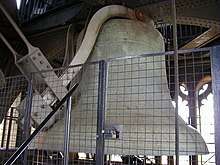
The quarter bells play a once-repeating, 20-note sequence of rounds and four changes in the key of E major: 1–4 at quarter past, 5–12 at half past, 13–20 and 1–4 at quarter to, and 5–20 on the hour (which sounds 25 seconds before the main bell tolls the hour). Because the low bell (B) is struck twice in quick succession, there is not enough time to pull a hammer back, and it is supplied with two wrench hammers on opposite sides of the bell. The tune is that of the Cambridge Chimes, first used for the chimes of Great St Mary's church, Cambridge, and supposedly a variation, attributed to William Crotch, based on violin phrases from the air "I know that my Redeemer liveth" in Handel's Messiah.[53][54] The notional words of the chime, again derived from Great St Mary's and in turn an allusion to Psalm 37:23–24, are: "All through this hour/Lord be my guide/And by Thy power/No foot shall slide". They are written on a plaque on the wall of the clock room.[55][56]
One of the requirements for the clock was that the first stroke of the hour bell should be correct to within one second per day. The tolerance is with reference to Greenwich Mean Time (BST in summer).[11][57][58] So, at twelve o'clock, for example, it is the first of the twelve hour-bell strikes that signifies the hour (the New Year on New Year's Eve at midnight). The time signalled by the last of the "six pips" (UTC) may be fractionally different.
Nickname
The origin of the nickname Big Ben is the subject of some debate. The nickname was applied first to the Great Bell; it may have been named after Sir Benjamin Hall, who oversaw the installation of the Great Bell, or after English heavyweight boxing champion Benjamin Caunt.[1][46][59] Now Big Ben is often used, by extension, to refer to the clock, the tower and the bell collectively, although the nickname is not universally accepted as referring to the clock and tower.[2][60][61][62] Some authors of works about the tower, clock and bell sidestep the issue by using the words Big Ben first in the title, then going on to clarify that the subject of the book is the clock and tower as well as the bell.[33][63]
In August 2017, satirical news site The Rochdale Herald published a spoof article stating that the bell was to be renamed "Massive Mohammed". Many people mistook this for a genuine news story and were widely ridiculed on social media.[64][65][66] This even inspired the creation of two online petitions.
Cultural significance
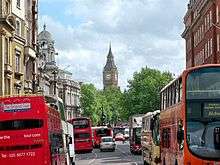
The clock has become a cultural symbol of the United Kingdom, particularly in the visual media. When a television or film-maker wishes to indicate a generic location in the country, a popular way to do so is to show an image of the tower, often with a red double-decker bus or black cab in the foreground.[67]
In 2008, a survey of 2,000 people found that the tower was the most popular landmark in the United Kingdom.[68] It has also been named as the most iconic film location in London.[69]
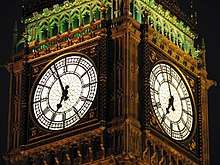
The sound of the clock chiming has also been used this way in audio media, but as the Westminster Quarters are heard from other clocks and other devices, the sound is by no means unique. Big Ben is a focal point of New Year celebrations in the United Kingdom, with radio and television stations airing its chimes to welcome the start of the New Year. To welcome in 2012, the clock tower was lit with fireworks that exploded at every toll of Big Ben.[70] Similarly, on Remembrance Day, the chimes of Big Ben are broadcast to mark the 11th hour of the 11th day of the 11th month and the start of the two minutes' silence.[71] The chimes of Big Ben have also been used at the state funerals of monarchs on three occasions: firstly, at the funeral of King Edward VII in 1910, when Big Ben chimed 68 times, one stroke for each year of the monarch's life; secondly, at the funeral of King George V in 1936 (70 strokes); and finally, at the funeral of King George VI in 1952 (56 strokes).[72]
Londoners who live an appropriate distance from the tower and Big Ben can, by means of listening to the chimes both live and on analogue radio, hear the bell strike thirteen times. This is possible because the electronically transmitted chimes arrive virtually instantaneously, while the "live" sound is delayed travelling through the air since the speed of sound is relatively slow.[73]
ITN's News at Ten opening sequence formerly featured an image of the tower with the sound of Big Ben's chimes punctuating the announcement of the news headlines of the day.[74] The Big Ben chimes (known within ITN as "The Bongs") continue to be used during the headlines and all ITV News bulletins use a graphic based on the Westminster clock dial. Big Ben can also be heard striking the hour before some news bulletins on BBC Radio 4 (6 p.m. and midnight, plus 10 p.m. on Sundays) and the BBC World Service, a practice that began on 31 December 1923. The sound of the chimes is sent live from a microphone permanently installed in the tower and connected by line to Broadcasting House.[75]
At the close of the polls for the 2010 general election the results of the national exit poll were projected onto the south side of the tower.[76] On 27 July 2012, starting at 8:12 a.m, Big Ben chimed 30 times, to welcome the Games of the 30th Olympiad, which officially began that day, to London.[77]
2017 renovation
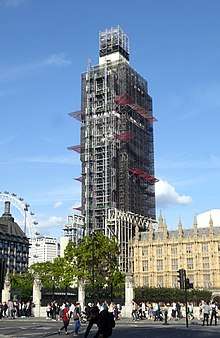
On 21 August 2017, Big Ben's chimes were silenced for four years to allow essential restoration work to be carried out on the tower. The decision to silence the bells was made to protect the hearing of the workers on the tower, and drew much criticism from senior MPs and the then Prime Minister Theresa May.[78] The striking and tolling of the bells for important occasions, such as New Year's Eve and Remembrance Sunday, will be handled via an electric motor; and at least one of the four clock faces will remain visible during the restoration. Scaffolding was put up around the tower immediately after the bells were silenced. The original cost of the project to the taxpayers and creditors was estimated to be roughly £29 million, but this was then more than doubled, to £69 million.[79] In February 2020 it was confirmed that the renovations had revealed that the Elizabeth Tower had sustained greater damage than originally thought in the May 1941 bombing raid that destroyed the adjacent House of Commons. Other costly discoveries included asbestos in the belfry, the "extensive" use of lead paint, broken glass on the clock dials, and serious deterioration to the tower's intricate stone carvings due to air pollution.[80] The cost of addressing the new problems was estimated at ₤18.6 million, bringing the total budget for restoring the Elizabeth Tower to nearly ₤80 million.[80] The additional renovation work was not set to derail the completion of the project: Big Ben will resume its usual striking and tolling in 2021.[81]
The aim of the renovation is to repair and conserve the tower, upgrading facilities as necessary, and ensuring the tower's integrity for future generations. The last significant renovation work to the tower was carried out in 1983–85. The 96-metre (315 ft) high structure is exposed to the elements, resulting in cracks and other damage to the masonry and rust damage to the ironwork. The 2,567 cast-iron roof tiles will be removed and replaced, and a lift will be installed to make access easier, along with a basic washroom with running water. The Ayrton Light at the top of the tower, which is lit when Parliament is sitting, will also be fully dismantled and restored with the other lights in the Belfry, the lights being replaced with low energy LEDs.[82] One of the most visible changes to the tower will be the restoration of the clock-face framework to its original colour of Prussian blue, used when the tower was first built in 1859, with the black paint used to cover up the soot-stained dial frames being stripped away. The clock faces are also to be regilded, and the shields of St George are to be repainted in their original red and white colours. The 1,296 pieces of glass that make up the clock faces are also to be removed and replaced.[83][84]
See also

- Big Ben Aden
- Little Ben
References
- "The Story of Big Ben". Whitechapel Bell Foundry. Retrieved 10 April 2018.
- Fowler, H. W. (1976). The Concise Oxford dictionary of current English. First edited by H. W. Fowler and F. G. Fowler (Sixth ed.). Clarendon Press. p. 95. ISBN 978-0-19-861121-9.
Big Ben, great bell, clock, and tower, of Houses of Parliament
- "Big Ben 'bongs' to be silenced for £29m refurbishment". BBC News. BBC. 26 April 2016. Retrieved 26 April 2016.
- Excell, Jon (5 July 2016). "Why is Big Ben falling silent?". BBC.
- "Join in the anniversary celebrations". UK Parliament. Archived from the original on 2 February 2009.
- "Palace of Westminster and Westminster Abbey including Saint Margaret's Church". UNESCO.
- "Big Ben in films and popular culture". The Daily Telegraph. 8 November 2016.
- "Frequently asked questions: Big Ben and Elizabeth Tower". UK Parliament.
- "1289-1834: Big Ben and Elizabeth Tower". UK Parliament. Retrieved 9 July 2014.
- Hill, Rosemary (3 March 2009). God's Architect: Pugin & the Building of Romantic Britain. Yale University Press. p. 482. Retrieved 9 July 2014.
- "Bong! Big Ben rings in its 150th anniversary". NBC News. Associated Press. 29 May 2009. Retrieved 1 June 2009.
- "Clock Tower tour". UK Parliament. 21 April 2010. Retrieved 30 September 2010.
- "Tunnel Vision" (PDF). Post Report Summary. Parliamentary Office of Science and Technology. January 1997. Archived from the original (PDF) on 21 November 2006.
- "Clock ticking for leaning Big Ben". BBC News. 11 October 2011.
- Hough, Andrew (2 June 2012). "The Queen's Diamond Jubilee: 'Big Ben to be renamed Elizabeth Tower'". The Daily Telegraph. Retrieved 9 July 2014.
- Rath, Kayte (26 June 2012). "Big Ben's tower renamed Elizabeth Tower in honour of Queen". BBC.
- "Questions to the Prime Minister". House of Commons Hansard Debates for 12 Sept 2012. Hansard. Retrieved 13 September 2012.
- U K Parliament (12 September 2012). "Elizabeth Tower naming ceremony". Retrieved 30 April 2016.
- "Denison, Dent and delays". Building the Great Clock. London: UK Parliament. 13 November 2009. Archived from the original on 4 December 2009. Retrieved 23 November 2009.
- "Great Clock facts". Big Ben. London: UK Parliament. 13 November 2009. Archived from the original on 7 October 2009. Retrieved 23 November 2009.
- "How Does Big Ben Keep Accurate Time?". Unearthed. YouTube. 30 August 2016. Science Channel.
- "BigBenFacts". www.bigbenfacts.co.uk. Archived from the original on 8 May 2017. Retrieved 31 January 2018.
- Jardine, Cassandra (29 May 2009). "Let's hear it again from Big Ben". The Daily Telegraph. London.
- "Big Ben". The Herald (Melbourne). 5 January 1878. p. 3. Retrieved 2 April 2019.
- "Big Ben". The Kyneton Observer. 10 January 1878. p. 2. Retrieved 2 April 2019.
- MacDonald, Peter (13 October 2005). Big Ben: The Bell, the Clock and the Tower. The History Press. ISBN 978-0-7524-9549-1. Retrieved 18 June 2017.
- "Snow Stops Big Ben". The Labor Daily (Sydney). 30 December 1927. p. 1. Retrieved 2 April 2019.
- "Big Ben Stops on Holiday". News (Adelaide). 3 April 1934. p. 10. Retrieved 2 April 2019.
- "Big Ben stopped by hammer". The Morning Bulletin. Rockhampton. 6 June 1941. Retrieved 11 May 2014.
- "Big Ben's big clean". BBC News. 21 August 2001.
- Plester, Jeremy (9 November 2016). "Bell tolls for Big Ben: snow, ice and sunflower effect stop the clock". The Guardian.
- "Big Ben to be silent for Baroness Thatcher's funeral". BBC News. 15 April 2013. Retrieved 7 February 2014.
- Macdonald, Peter G (25 January 2005). Big Ben: The Bell, The Clock And The Tower. Stroud, Gloucestershire. ISBN 978-0-7524-9549-1.
- "Big Ben chimes stoppage mystery". BBC News. 28 May 2005. Retrieved 26 April 2010.
- "In pictures: Big Ben's big turn off". BBC News. 29 October 2005. Retrieved 26 April 2010.
- Hutton, Robert (4 June 2006). "Big Ben's Chime Won't Sound the Same to Londoners for a While". Bloomberg. Retrieved 30 September 2010.
- Rippon, Peter (12 June 2006). "The Editors: Bongs and Birds". BBC News. Retrieved 10 April 2017.
- "Big Ben silenced for repair work". BBC News. 11 August 2007. Retrieved 26 April 2010.
- "Big Ben 1859 – 2009 – Keeping the Great Clock ticking". UK Parliament. Archived from the original on 3 June 2009. Retrieved 27 May 2009.
- Brand, Stewart (2008). The Clock of the Long Now. New York: Basic Books. ISBN 978-0-7867-2292-1.
- Watt, Nicholas (15 April 2013). "Margaret Thatcher funeral: Big Ben to be silenced as mark of respect". The Guardian. London. Retrieved 17 May 2013.
- Phipps, Claire (25 August 2015). "Clockwatchers ticked off as Big Ben's chimes run seven seconds fast". The Guardian. Retrieved 30 August 2015.
- "Big Ben's bongs to fall silent until 2021 for repairs". BBC News. London. 14 August 2017. Retrieved 14 August 2017.
- "MPs are gathering outside Big Ben to watch it bong for the final time". The Independent. 21 August 2017.
- "Big Ben WILL still bong for New Year's Eve and Remembrance Day". London Evening Standard.
- "The Great Bell – Big Ben". UK Parliament. Retrieved 9 July 2014.
- "Big Ben" (PDF). House of Commons. 2012. Retrieved 10 April 2020.
- ICONS England. "Big Ben – How did Big Ben get its Name?". Icons of England. Archived from the original on 24 January 2010. Retrieved 30 April 2016.
- The actual weight quoted by the founders is 13 tons 10 cwts 3 qtrs 15 lbs.
- "The History of Great Paul". Bell foundry museum, Leicester. Archived from the original on 30 September 2007. Retrieved 19 October 2008.
- "The New Houses of Parliament". The Standard. London. 16 November 1855. p. 2.
- McKay, Chris (27 May 2010). Big Ben: the Great Clock and the Bells at the Palace of Westminster. Oxford University Press. 2.47–48. ISBN 978-0-19-958569-4. Retrieved 13 April 2017.
- Phillips, Alan (1959). The Story of Big Ben. Her Majesty's Stationery Office. p. 13.
- Starmer, William Wooding (1910). Quarter Chimes and Chime Tunes. London: Novello. pp. 6–8.
- Milmo, Cahel (5 June 2006). "Bong! A change of tune at Westminster". The Independent. London. Retrieved 8 April 2008.
- Lockyer, Herbert (1 January 1993). A Devotional Commentary on Psalms. Grand Rapids, Michigan: Kregel Christian Books. p. 149. ISBN 978-0-8254-9742-1.
- Steve Jaggs, Keeper of the Clock, interviewed on Sky News, 26 April 2016.
- "The Story of Big Ben". Whitechapel Bell Foundry. Retrieved 9 July 2014.
- "The Great Bell – Big Ben". Living Heritage. UK Parliament. 13 November 2009. Retrieved 28 July 2012.
- Betts, Jonathan D. (26 November 2008). "Big Ben". Encyclopædia Britannica. Encyclopædia Britannica Online. Archived from the original on 2 November 2008. Retrieved 27 October 2008.
- "Big Ben". The Columbia Encyclopedia. Columbia University Press. July 2001. Archived from the original on 10 October 2008. Retrieved 27 October 2008.
- "Big Ben". Encarta World English Dictionary [North American Edition]. Microsoft Corporation. 2009. Archived from the original on 31 October 2009. Retrieved 14 January 2009.
- Lockhart, Ann (1997). Big Ben and the Westminster Clock Tower. Stroud, Gloucestershire. ISBN 978-0-85372-839-9.
- Nagesh, Ashitha (17 August 2017). "People actually believed that Big Ben was going to be renamed 'Massive Mohammed'". Metro. London. Retrieved 23 August 2017.
- "This Fake Story Claiming Big Ben Will Be Renamed For Muslims Is Making A Lot of People Mad". BuzzFeed. Retrieved 23 August 2017.
- "Someone joked that Big Ben would be renamed Massive Mohammed and people were furious". Indy100. 18 August 2017. Retrieved 23 August 2017.
- Patterson, John (1 June 2007). "City Light". The Guardian. London. Archived from the original on 18 June 2008. Retrieved 26 December 2016.
- "Big Ben 'UK's favourite landmark'". BBC News. 9 April 2008. Retrieved 26 April 2010.
- "Big Ben most iconic London film location". Metro. London. 21 October 2007. Retrieved 30 April 2016.
- "Fireworks going off at the London Eye and Big Ben to welcome 2012 in London". BBC One. Retrieved 31 December 2011.
- "Remembrance Day across the UK". BBC News. 14 November 2004. Retrieved 13 August 2012.
- Weinreb, Ben and Hibbert, Christopher (1992). The London Encyclopaedia (reprint ed.). Macmillan. p. 66.CS1 maint: uses authors parameter (link)
- "How to make Big Ben's clock strike 13". BBC News. 4 November 2010. Retrieved 13 August 2012.
- Robinson, James (22 October 2009). "ITV to drop Big Ben from News at Ten titles". The Guardian. London. Retrieved 13 August 2012.
- "Big Ben Microphone". BBC. Retrieved 15 April 2015.
- "General election results beamed onto Big Ben". UK Parliament. Archived from the original on 11 November 2010. Retrieved 30 April 2016.
- "Big Ben rings in Olympic Morning". ITV News. YouTube. 27 July 2012. Retrieved 10 April 2018.
- Hughes, Laura (16 August 2017). "Theresa May says 'it can't be right for Big Ben to be silent for four years'". The Telegraph. ISSN 0307-1235. Retrieved 12 July 2019.
- "Big Ben tower repair costs double". 29 September 2017. Retrieved 12 July 2019.
- Rajeev Syal (13 February 2020). "Wartime bomb damage and asbestos inflates Big Ben repair bill to ₤80m". The Guardian. Retrieved 13 February 2020.
- "Big Ben's bongs to fall silent until 2021". 14 August 2017. Retrieved 12 July 2019.
- "Big Ben to be silenced for £29m refit". 26 April 2016. Retrieved 12 July 2019.
- "Big Ben Has Been Repainted Blue". Londonist. 21 March 2019. Retrieved 12 July 2019.
- "Elizabeth Tower contract awarded – News from Parliament". UK Parliament. Retrieved 12 July 2019.
External links
- Official website of Big Ben at UK Parliament
- The Palace of Westminster at UK Parliament
- Big Ben at Whitechapel Bell Foundry
- Big Ben's Clapper at Houghton-le-Spring Heritage Society
- Interior photos of the tower at UK Parliament's Flickr
- "A tale of Two Towers: Big Ben and Pisa"—transcript of a lecture by Prof. John Burland
Videos
- The Mechanical Genius of Big Ben (2017) documentary by Discovery
- Big Ben's a Hundred (1959) newsreel by British Pathé
- Big Ben's Clean Up (1955) by British Pathé
- Big Ben (1948) by British Pathé
